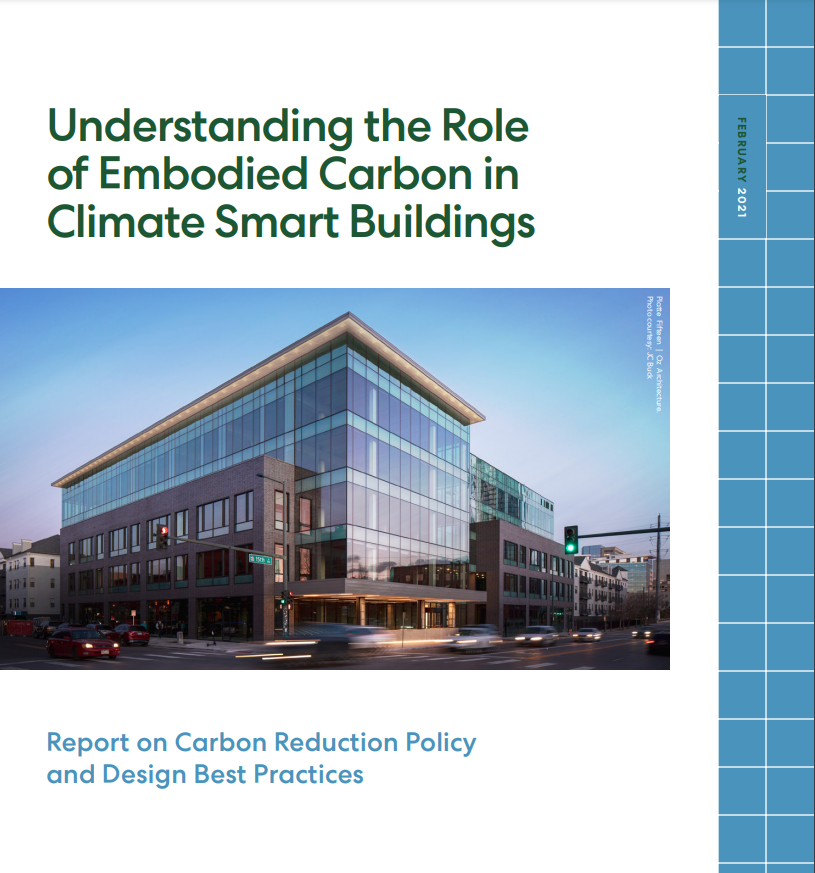ThinkWood Report: Embodied Carbon in Climate Smart Buildings (February 2021)
What is it?
Embodied carbon for building materials is a measure of the greenhouse gas (GHG) emissions associated with one or more life cycle stages. Total embodied carbon is attributed to the entire life cycle of the building material, including the manufacturing, maintenance, decommissioning and end of life of a building.8 Embodied carbon is different than operational carbon, which is the carbon emissions from producing the energy used to operate a building once it is completed. Examples of operational carbon sources include HVAC systems, water heaters, pumps, fans and other critical motors.
Embodied carbon can include a portion of or the entire life cycle of the materials used in a construction project, from the moment that material is either harvested (trees for wood) or excavated (mined minerals for steel and concrete) to the moment it is returned (e.g. landfilled or composted), recycled, or reused.
Why is it important?
The built environment is growing at a record pace in the United States. In just one sector, it is estimated that 2.5 million new housing units are needed to make up for the nation’s housing shortage.10 To reduce the GHG emissions associated with that construction, communities need to act now to create embodied carbon strategies that reduce environment impacts from buildings we’ll use well into the future.
Where is it??
Embodied carbon can be determined for most products by evaluating each step in its life cycle. Besides building products, it can be measured for roads, vehicles, and even bananas.11
The amount of embodied carbon can be significant in buildings. Building materials all require energy to be extracted and processed. Energy is needed to transport materials to a job site and during construction. As the building is decommissioned, the process of deconstruction, recycling, repurposing or landfilling produces emissions for the various building materials.
Embodied carbon varies dramatically between concrete, steel and wood, making product decisions key in achieving lower carbon buildings. Manufacturing wood products is less energy intensive than the process for concrete or steel, which contributes to their low embodied carbon.
How is it measured?
Embodied carbon is determined by conducting a life cycle assessment (LCA) of a product, assembly or the building over declared life cycle stages. An LCA study returns results for a number of environmental metrics, including the potential to impact climate or “global warming potential” (GWP). Embodied carbon is the GWP result. Embodied carbon is measured for each stage of the product’s life cycle, allowing comparisons across any combination of stages.
“To reduce the GHG emissions associated with that construction, communities need to act now to create embodied carbon strategies that reduce environment impacts from buildings we’ll use well into the future.”
Who is working on it?
Embodied carbon is a priority for many environmental, architecture, and urban planning organizations including C40 Cities,12 Architecture 2030,13 Urban Land Institute,14 and the World Green Building Council.15 Of particular note are two international policy reviews of embodied carbon by Forestry Innovation Investment and Bionova, sponsored by the Finnish Ministries of the Environment and Transport.16 17
Many experts believe addressing embodied carbon for buildings and building materials is critical to achieve the goals of the Intergovernmental Panel on Climate Change (IPCC) and the 2016 Paris Climate Agreement.
When is the best time to act?
In short, by making embodied carbon reduction a priority today, builders, architects, planners and city leaders can reduce the environmental impact of new construction and create a healthier community for generations to come. The first step of any strategy begins with a commitment to change. Planners can advocate for climate smart buildings and projects. Government agencies can invest in tools to assess building carbon footprints and compare design scenarios to identify the best options. Local leaders can develop programs and policies to support and incentivize reducing the carbon footprint of the built environment.
The costs of delaying any longer are too high. Greenhouse gas emissions have increased by 90% since 1970.18 A 1.5% increase in global warming will have catastrophic results for ecosystems and people around the world, including the United States.19 Communities can’t afford to wait.
In fact, many U.S. states and cities have created their own carbon action plans that can provide a roadmap for action. Recognizing there is no one-size-fits-all solution, the authors of this report instead present a snapshot of the current embodied carbon landscape — both policies and design best practices — in the U.S., Canada and Europe in order to facilitate a better understanding of embodied carbon and the impactful role it plays in climate smart buildings.

